Help completing the code for this assigment its java code th
Help completing the code for this assigment, it\'s java code. the highlighted part needs to be done(the domain class only), everything else is done already.
the logistic so it can check every row and column,
The Universal Sudoku Puzzle in the newspaper provides directions for completing a Sudoku puzzle: “Complete the grid so that every row, column, and 3 x 3 box contains every digit from 1 to 9 inclusively.” Here is an example of a completed Sudoku:
Notice that each row and column contains the integers 1 to 9. This is also true of the nine 3 x 3 subsquares.
Mathematicians would say that a Sudoku puzzle is a special example of another mathematical object called a Latin square. Latin squares of size n x n satisfy the property that every row and every column contain the integers 1, 2, …, n. In fact we say that a row or column has the “Latin property” if it contains exactly the integers 1, 2, …, n. For Sudoku we can extend the notion to subsquares as well, so if a 3 x 3 subsquare contains 1, 2, …, 9, we say the subsquare satisfies the Latin property. With these definitions, a Sudoku square has the property that every row, column, and 3 x 3 subsquare is Latin.
Here is an invalid Sudoku arrangement:
Notice that in the square above, the second row, the seventh column, and the top-right subsquare do not satisfy the Latin property, while all other rows, columns and subsquares do satisfy the Latin property.
The Java code listed below has a main method that creates and prints three Sudoku puzzles. Each puzzle is created by calling the static method makeSudoku(String s), passing it an 81 character String that contains the contents of a single puzzle. The rows of the puzzle are listed in sequence in the string. The method converts the passed String to a two-dimension array of strings (each String containing a single digit) which is returned to the calling program.
The code below also contains a method called getPrintableSudoku(String[][] x). This method is passed the two-dimensional array representation of the puzzle, and returns a formatted String which can be printed to produce a two-dimensional representation on a page.
You will need to provide the body for the method isValidSudoku(String[][] x). Complete this method so it returns true or false based on whether the puzzle arrangement is a complete and valid Sudoku puzzle.
There are many approaches you can take in tackling this problem. Because the solution involves testing rows, columns, and subsquares, you will probably want to introduce a collection of helper methods to break the problem into simpler subtasks.
At the top level, we need to develop a method isValidSudoku so that it checks that 1) each row is Latin, 2) each column is Latin, and 3) each subsquare contains 1, 2, …, 9.
Let’s decompose isValidSudoku into three Boolean methods called rowsAreLatin, colsAreLatin, and goodSubsquares, which correspond to the tasks listed above. Each of these three methods can be further decomposed as well. For example, rowsAreLatin can be decomposed into a subordinate method rowIsLatin(int i) which examines a single row. (The other methods can be decomposed in a similar way.)
In designing rowIsLatin(String[][] x, int i), it is evident that we need a method of insuring that each symbol 1, 2, …, 9 appears in row i. One technique is to create a boolean array called found with the property that found[k] is true if symbol k occurs in row[i]. We can start by initializing the found array to all false values to indicate that none of the symbols 1, 2, …, 9 have yet be found in the current row.
For each String item in a Sudoku row, you change it to an int by invoking Integer.parseint(String) and use the resulting number as a subscript into the found array, setting the corresponding element true. As an example, if the first item in a row is 6, we need to set found[6] = true. (Hint: You will need to code something like found[k] = true where k takes on each integer value represented by the String values in the row.) When you have completed examination of a row, the entire found array should contain only true values if each symbol has occurred exactly once in the row.
To help you get started, we have provided a main method that creates and prints three Sudoku objects. It also contains the needed method headers that we discussed in our approach to decomposing the problem.
Solution
import java.util.Arrays;
public class Sudoku
{
private byte[][] myPuzzle = new byte[][]
{
{ 0, 0, 0, 0, 0, 0, 0, 0, 0 },
{ 0, 0, 0, 0, 0, 0, 0, 0, 0 },
{ 0, 0, 0, 0, 0, 0, 0, 0, 0 },
{ 0, 0, 0, 0, 0, 0, 0, 0, 0 },
{ 0, 0, 0, 0, 0, 0, 0, 0, 0 },
{ 0, 0, 0, 0, 0, 0, 0, 0, 0 },
{ 0, 0, 0, 0, 0, 0, 0, 0, 0 },
{ 0, 0, 0, 0, 0, 0, 0, 0, 0 },
{ 0, 0, 0, 0, 0, 0, 0, 0, 0 }
};
public Sudoku(String incomingPuzzle)
{
if ( incomingPuzzle.length() != 81 )
{
System.out.println(\"Invalid Sudoku puzzle syntax. Should be 81 numbers.\");
System.exit(1);
}
for ( int row = 0; row <= 8; row++ )
{
for ( int column = 0; column <= 8; column++ )
{
myPuzzle[row][column] = convertCharToByte(incomingPuzzle.charAt(row*9+column));
}
}
if ( puzzleIsValid() == false )
{
System.out.println(\"Illegal puzzle.\");
System.exit(1);
}
}
public void printPuzzle()
{
for ( byte y = 0; y <=8; y++ )
{
for ( byte x = 0; x <=8; x++ )
{
System.out.print(myPuzzle[y][x] + \" \");
if ( x == 2 || x == 5 )
{
System.out.print(\" \");
}
}
System.out.println();
if ( y == 2 || y == 5 || y == 8 )
{
System.out.println();
}
}
}
public void solvePuzzle()
{
solvePuzzle(false);
}
public void solvePuzzle(boolean showDetails)
{
// print puzzle in the console
System.out.println(\"Unsolved puzzle:\");
printPuzzle();
byte cyclesElapsed = 1;
// iterate through each square in a 9x9 sudoku puzzle and try to solve the square
while ( true )
{
byte squaresSolved = 0;
// We need some way to pause execution if the puzzle either becomes solved or is discovered to be unsolvable.
boolean somethingChanged = false;
// check each square
for ( byte square = 1; square <= 9; square++ )
{
// when we do our x-ray checks later we will need to know what row numbers and what column numbers to check
byte[] coordinates = getSquareCoordinates(square, (byte) 1);
byte checkThisRowFirst = coordinates[1];
byte checkThisColumnFirst = coordinates[0];
// make a boolean array to keep track of whether or not a coordinate in the square can be a solution for that numToCheck
// true = possibly a solution, false = not a solution
// once we are down to 1 true and 8 falses, we have solved that numToCheck and can update the box in myPuzzle
boolean[] possiblyContainsNum = new boolean[] {true, true, true, true, true, true, true, true, true};
// eliminate all occupied cells in the square
// iterate through the 9 boxes in the square and plug it into the getSquareCoordinates method
for ( byte i = 1; i <=9; i++ )
{
byte[] coordinates2 = getSquareCoordinates(square, i);
if ( myPuzzle[coordinates2[1]][coordinates2[0]] != 0 )
{
possiblyContainsNum[i-1] = false;
}
}
// check each number 1 through 9
// don\'t go box by box, go number by number
for ( byte numToCheck = 1; numToCheck <= 9; numToCheck++ )
{
// does the square contain this number already?
// if yes, skip. if no, try to solve
if ( squareContainsNumber(square, numToCheck) == false )
{
// I had possiblyContainsNum inside this loop for awhile, but then I realized it is
// more efficient to just compute it once and store it in memory. We\'ll make a new
// possiblyContainsNum for this numToCheck, copying the values of the original calculation
// (occupied squares) to start us off
boolean[] possiblyContainsNum2 = Arrays.copyOf(possiblyContainsNum, possiblyContainsNum.length);
// eliminate x-rays from rows and columns
// check the entire row or column (all 9 boxes), easier to code than 6 boxes
// row 1
if ( rowContainsNumber(checkThisRowFirst, numToCheck) == true )
{
possiblyContainsNum2[0] = false;
possiblyContainsNum2[1] = false;
possiblyContainsNum2[2] = false;
}
// row 2
if ( rowContainsNumber((byte) (checkThisRowFirst+1), numToCheck) == true )
{
possiblyContainsNum2[3] = false;
possiblyContainsNum2[4] = false;
possiblyContainsNum2[5] = false;
}
// row 3
if ( rowContainsNumber((byte) (checkThisRowFirst+2), numToCheck) == true )
{
possiblyContainsNum2[6] = false;
possiblyContainsNum2[7] = false;
possiblyContainsNum2[8] = false;
}
// column 1
if ( columnContainsNumber(checkThisColumnFirst, numToCheck) == true )
{
possiblyContainsNum2[0] = false;
possiblyContainsNum2[3] = false;
possiblyContainsNum2[6] = false;
}
// column 2
if ( columnContainsNumber((byte) (checkThisColumnFirst+1), numToCheck) == true )
{
possiblyContainsNum2[1] = false;
possiblyContainsNum2[4] = false;
possiblyContainsNum2[7] = false;
}
// column 3
if ( columnContainsNumber((byte) (checkThisColumnFirst+2), numToCheck) == true )
{
possiblyContainsNum2[2] = false;
possiblyContainsNum2[5] = false;
possiblyContainsNum2[8] = false;
}
// check possiblyContainsNum and see how many \"true\" cells there are
// if \"true\" cells == 1 then we have solved that numToCheck in that square
// go ahead and update myPuzzle[][]
byte counter = 0;
byte k = 0; // this will store the last value of j that was true
for ( byte j = 0; j <= 8; j++ )
{
if ( possiblyContainsNum2[j] == true )
{
counter++;
k = j;
}
}
if ( counter == 1 )
{
byte[] coordinates3 = getSquareCoordinates(square, (byte) (k+1));
myPuzzle[coordinates3[1]][coordinates3[0]] = numToCheck;
somethingChanged = true;
squaresSolved++;
}
}
}
}
if ( showDetails == true )
{
System.out.println(\"Iteration \" + cyclesElapsed + \" complete. Solved \" + squaresSolved + \" squares.\");
printPuzzle();
}
cyclesElapsed++;
// If no cells were solved during this iteration, that means that the puzzle is completely solved, is completely
// unsolvable, or is unsolvable using just this technique. Time to exit the loop.
if ( somethingChanged == false )
{
break;
}
}
// do a quick check and make sure the puzzle is solved
// if it isn\'t, throw an unsolvable puzzle error
if ( puzzleIsSolved() == false )
{
System.out.println(\"Unsolvable using just the LAST CANDIDATE technique. More advacned techniques are needed.\");
System.out.println(\"Try plugging the 81 digit number into the sudoku solver at http://www.sudokuwiki.org/sudoku.htm\");
System.out.println();
return;
}
// print puzzle in the console
System.out.println(\"Solved puzzle:\");
printPuzzle();
}
private byte convertCharToByte(char f)
{
switch ( f )
{
case \'0\':
return 0;
case \'1\':
return 1;
case \'2\':
return 2;
case \'3\':
return 3;
case \'4\':
return 4;
case \'5\':
return 5;
case \'6\':
return 6;
case \'7\':
return 7;
case \'8\':
return 8;
case \'9\':
return 9;
default:
System.out.println(\"Invalid Sudoku puzzle syntax. Should be 81 numbers.\");
System.exit(1);
}
return 0; // the compiler made me put this, logically it should be unreachable
}
private boolean puzzleIsValid()
{
// 1) check each row and make sure there is only 1 number per row
for ( byte y = 0; y <=8; y++ )
{
// we need a new oneThroughNine for each row, so we\'ll put this inside the \"y\" loop
boolean[] oneThroughNine = new boolean[] {false, false, false, false, false, false, false, false, false};
for ( byte x = 0; x <=8; x++ )
{
if ( myPuzzle[y][x] != 0 )
{
if ( oneThroughNine[myPuzzle[y][x] - 1] == false )
{
oneThroughNine[myPuzzle[y][x] - 1] = true;
}
else
{
return(false);
}
}
}
}
// 2) check each column and make sure there is only 1 number per column
for ( byte x = 0; x <=8; x++ )
{
// we need a new oneThroughNine for each column, so we\'ll put this inside the \"y\" loop
boolean[] oneThroughNine = new boolean[] {false, false, false, false, false, false, false, false, false};
for ( byte y = 0; y <=8; y++ )
{
if ( myPuzzle[y][x] != 0 )
{
if ( oneThroughNine[myPuzzle[y][x] - 1] == false )
{
oneThroughNine[myPuzzle[y][x] - 1] = true;
}
else
{
return(false);
}
}
}
}
// 3) check each square and make sure there is only 1 number per square
for ( byte square = 1; square <=9; square++ )
{
// we need a new oneThroughNine for each square, so we\'ll put this inside the \"y\" loop
boolean[] oneThroughNine = new boolean[] {false, false, false, false, false, false, false, false, false};
for ( byte i = 1; i <=9; i++ )
{
byte[] coordinates = getSquareCoordinates(square, i);
if ( myPuzzle[coordinates[0]][coordinates[1]] != 0 )
{
if ( oneThroughNine[myPuzzle[coordinates[0]][coordinates[1]] - 1] == false )
{
oneThroughNine[myPuzzle[coordinates[0]][coordinates[1]] - 1] = true;
}
else
{
return(false);
}
}
}
}
return(true);
}
private boolean puzzleIsSolved()
{
for ( byte y = 0; y <= 8; y++ )
{
for ( byte x = 0; x <= 8; x++ )
{
if ( myPuzzle[y][x] == 0 )
{
return(false);
}
}
}
return(true);
}
private byte[] getSquareCoordinates(byte squareNumber, byte i)
{
byte[] startCoordinates = null;
switch ( squareNumber )
{
case 1:
startCoordinates = new byte[]{0,0};
break;
case 2:
startCoordinates = new byte[]{3,0};
break;
case 3:
startCoordinates = new byte[]{6,0};
break;
case 4:
startCoordinates = new byte[]{0,3};
break;
case 5:
startCoordinates = new byte[]{3,3};
break;
case 6:
startCoordinates = new byte[]{6,3};
break;
case 7:
startCoordinates = new byte[]{0,6};
break;
case 8:
startCoordinates = new byte[]{3,6};
break;
case 9:
startCoordinates = new byte[]{6,6};
break;
}
byte[] finalCoordinates = null;
switch ( i )
{
case 1:
finalCoordinates = new byte[] {startCoordinates[0], startCoordinates[1]};
break;
case 2:
finalCoordinates = new byte[] {(byte) (startCoordinates[0]+1), startCoordinates[1]};
break;
case 3:
finalCoordinates = new byte[] {(byte) (startCoordinates[0]+2), startCoordinates[1]};
break;
case 4:
finalCoordinates = new byte[] {startCoordinates[0], (byte) (startCoordinates[1]+1)};
break;
case 5:
finalCoordinates = new byte[] {(byte) (startCoordinates[0]+1), (byte) (startCoordinates[1]+1)};
break;
case 6:
finalCoordinates = new byte[] {(byte) (startCoordinates[0]+2), (byte) (startCoordinates[1]+1)};
break;
case 7:
finalCoordinates = new byte[] {startCoordinates[0], (byte) (startCoordinates[1]+2)};
break;
case 8:
finalCoordinates = new byte[] {(byte) (startCoordinates[0]+1), (byte) (startCoordinates[1]+2)};
break;
case 9:
finalCoordinates = new byte[] {(byte) (startCoordinates[0]+2), (byte) (startCoordinates[1]+2)};
break;
}
return finalCoordinates;
}
private boolean squareContainsNumber(byte square, byte numToCheck)
{
for ( byte i = 1; i <= 9; i++ )
{
byte[] coordinates = getSquareCoordinates(square, i);
if ( myPuzzle[coordinates[1]][coordinates[0]] == numToCheck )
{
return(true);
}
}
return(false);
}
private boolean rowContainsNumber(byte rowToCheck, byte numToCheck)
{
for ( byte column = 0; column <= 8; column++)
{
if ( myPuzzle[rowToCheck][column] == numToCheck )
{
return(true);
}
}
return(false);
}
private boolean columnContainsNumber(byte columnToCheck, byte numToCheck)
{
for ( byte row = 0; row <= 8; row++)
{
if ( myPuzzle[row][columnToCheck] == numToCheck )
{
return(true);
}
}
return(false);
}
}
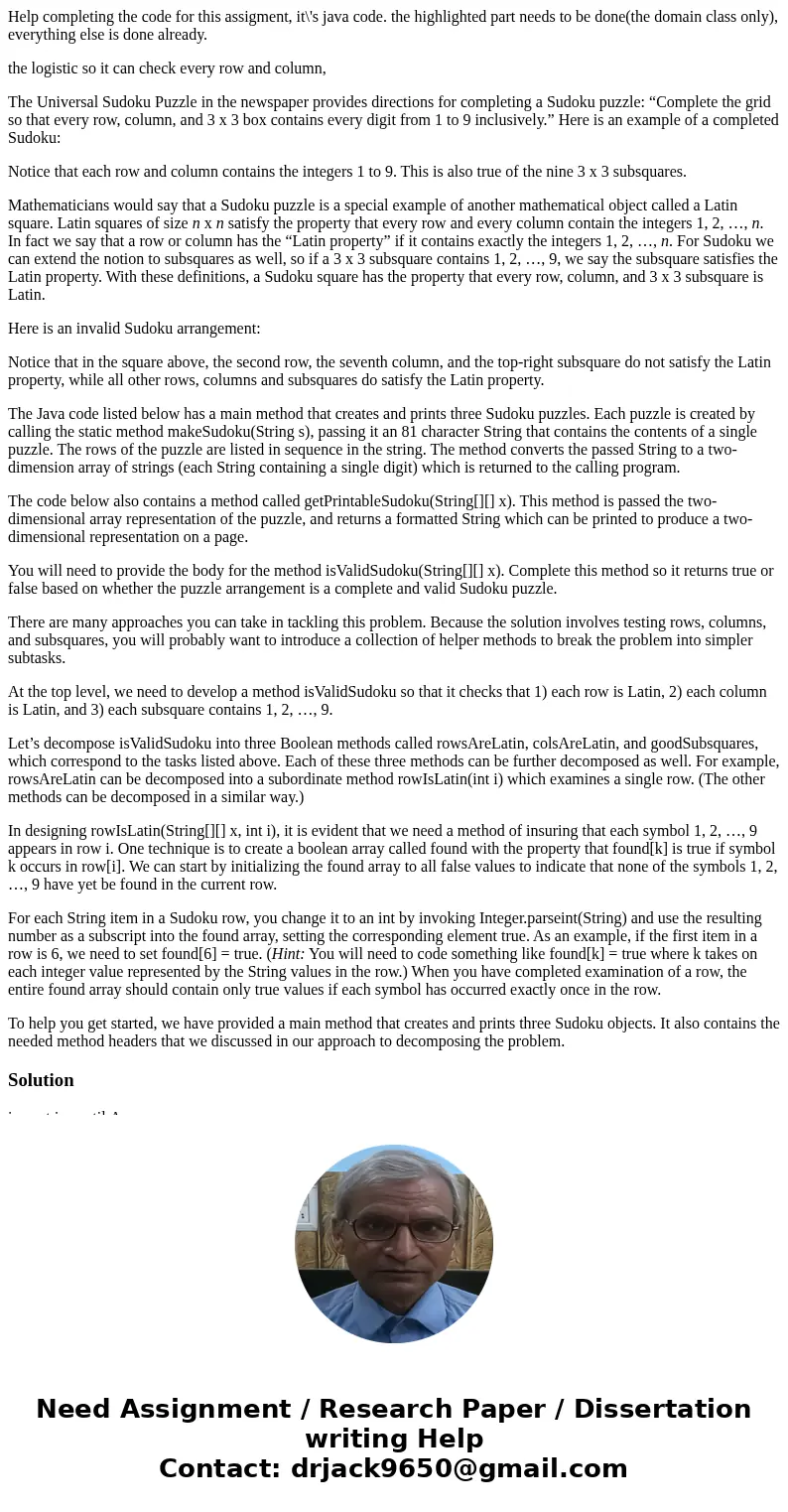
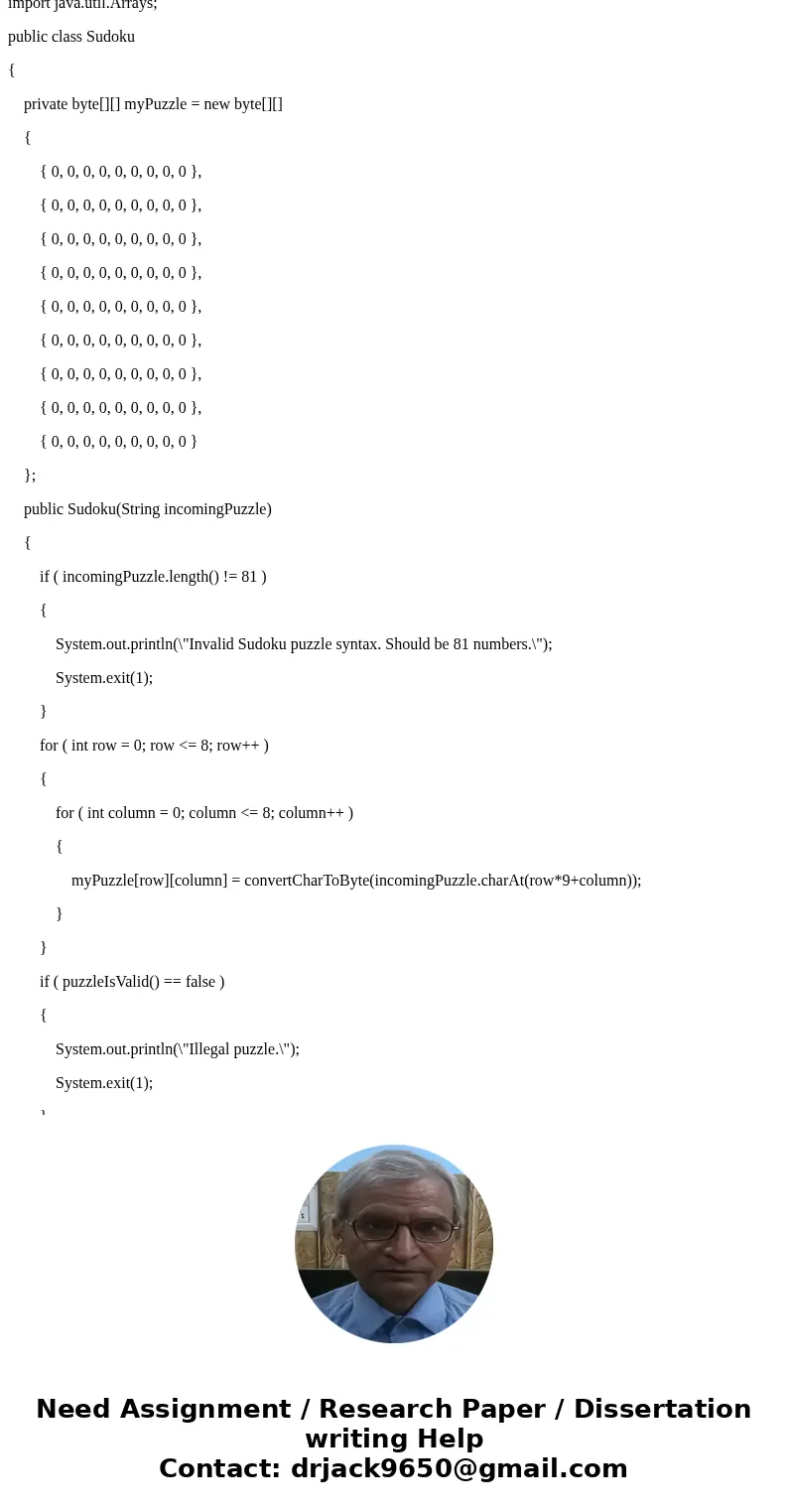
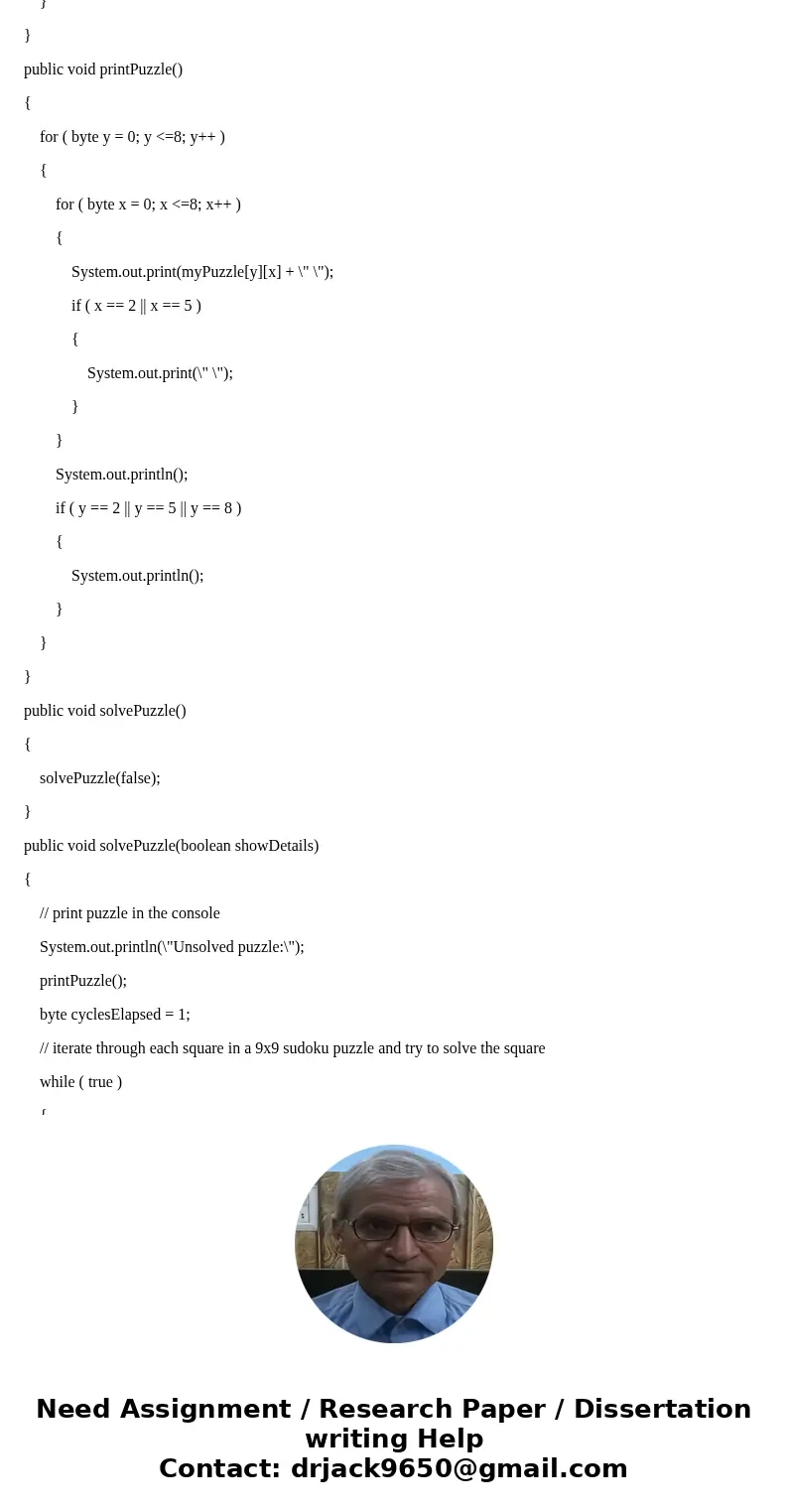
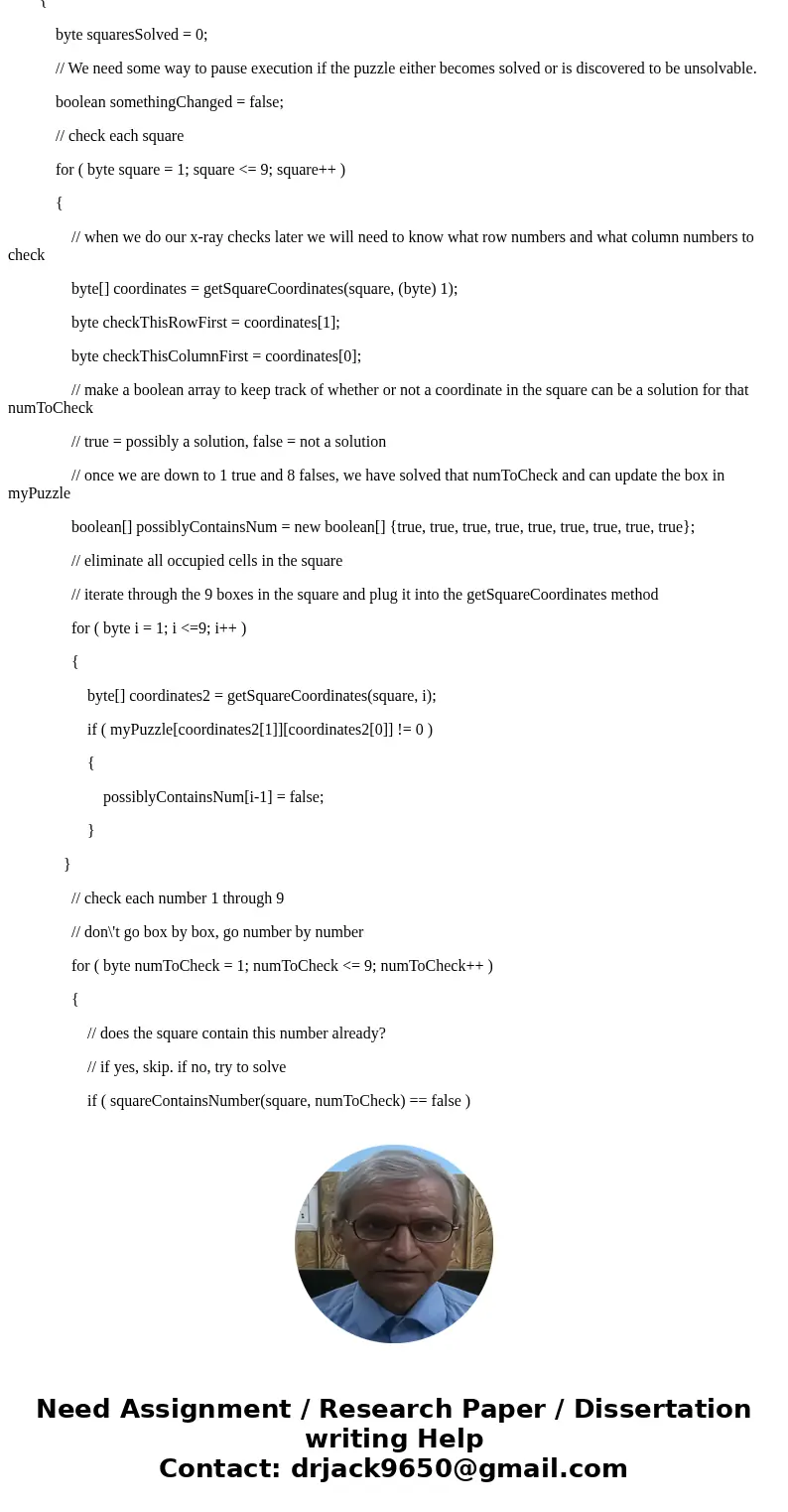
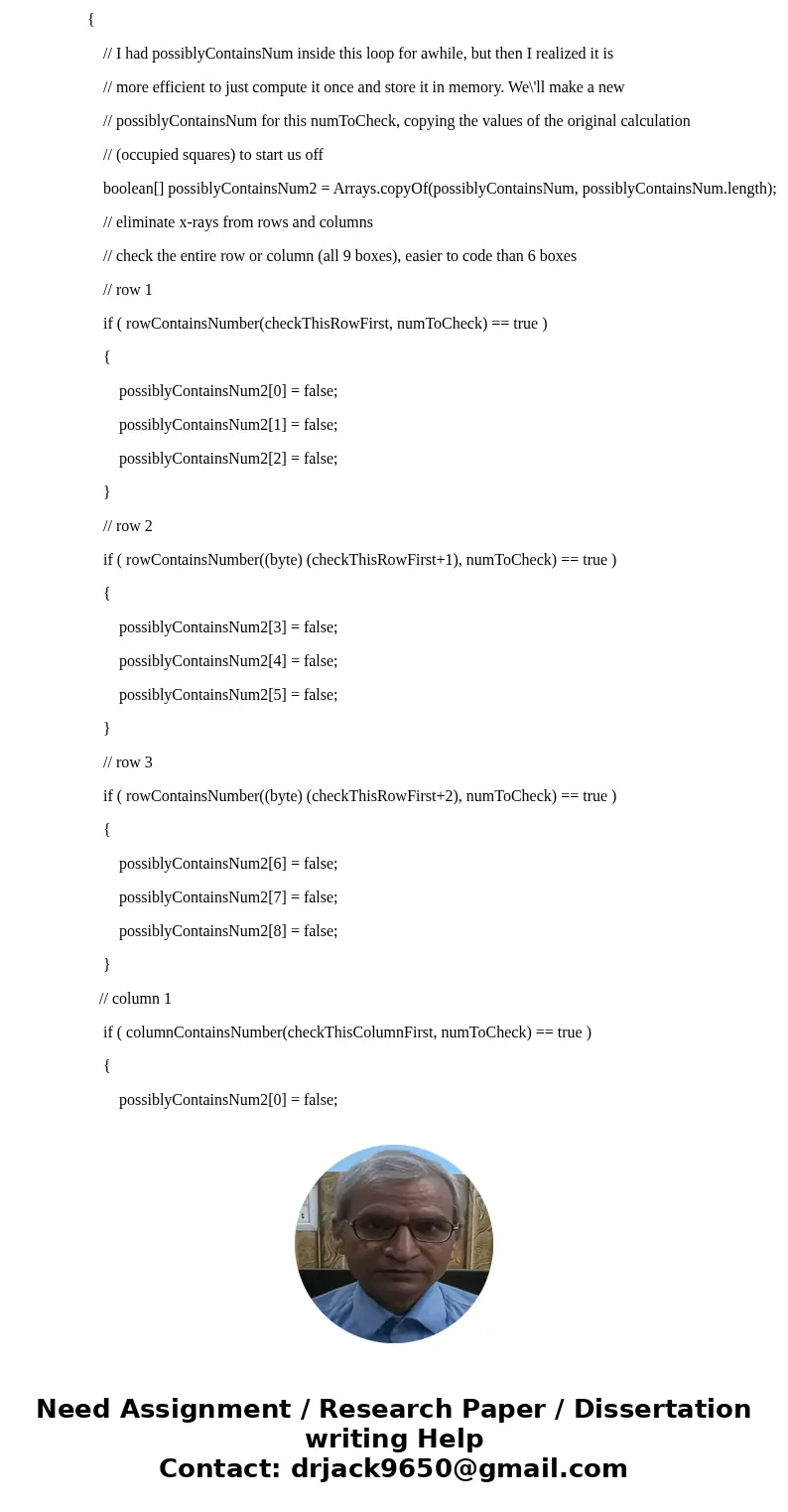
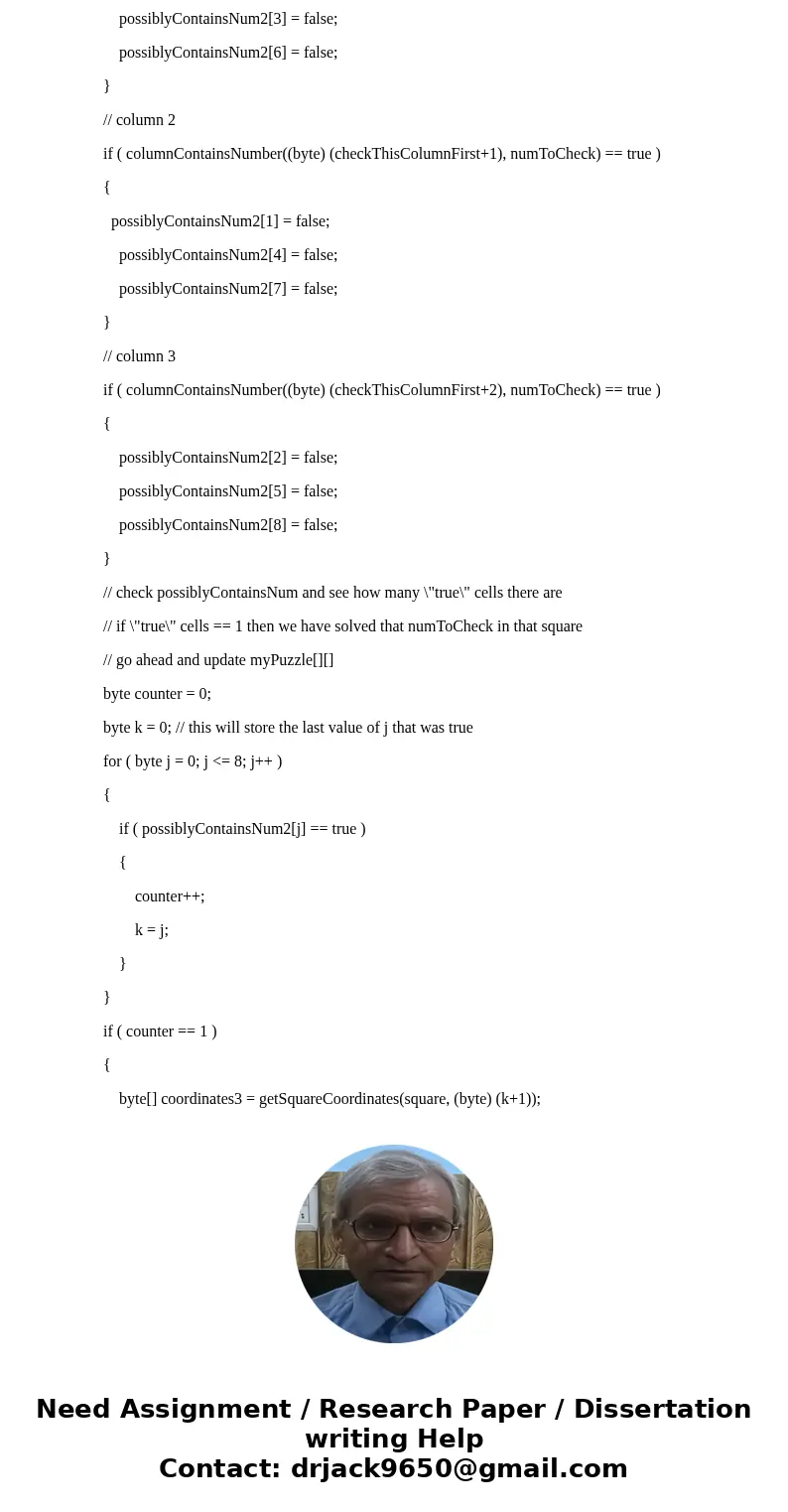
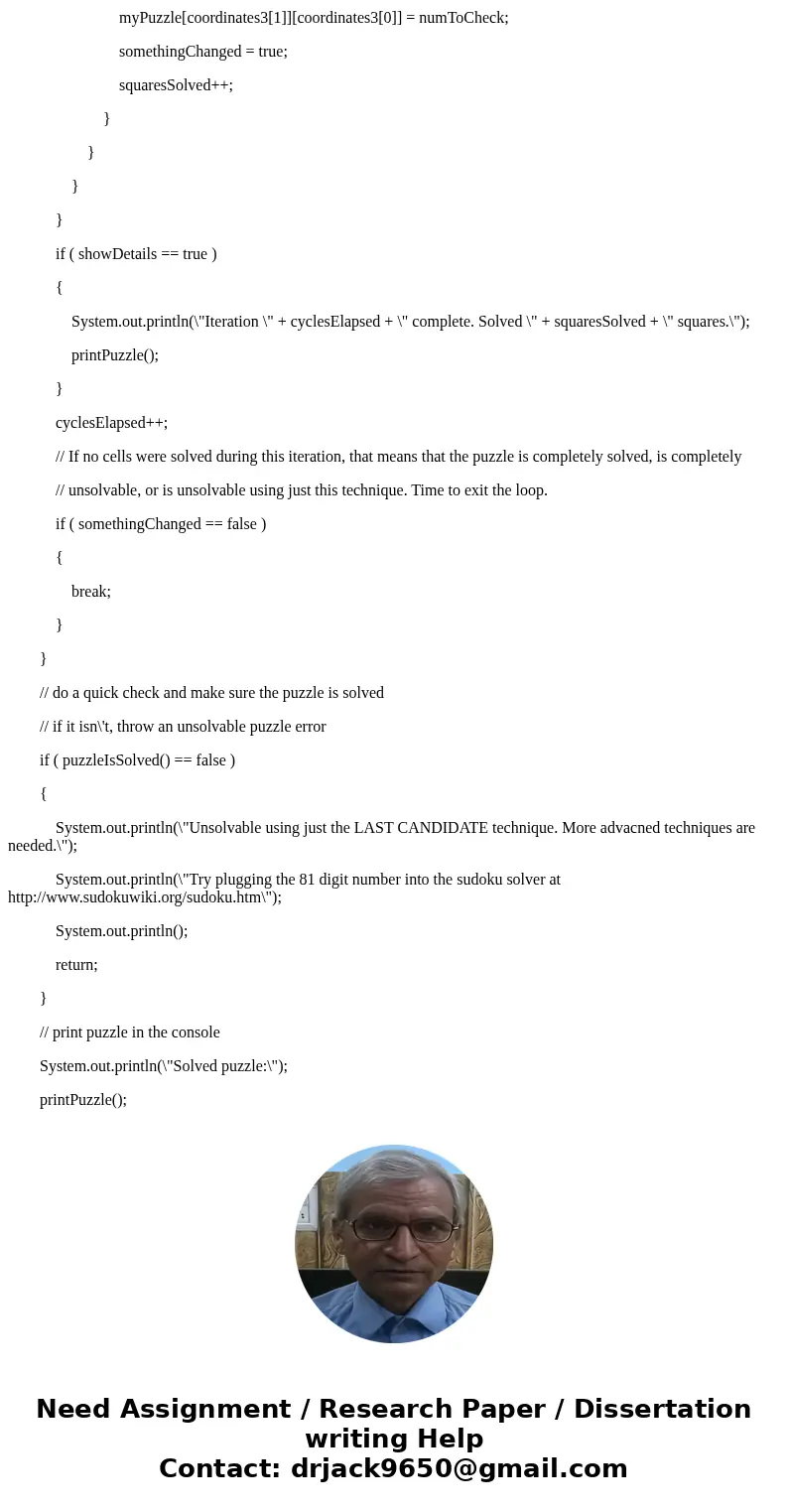
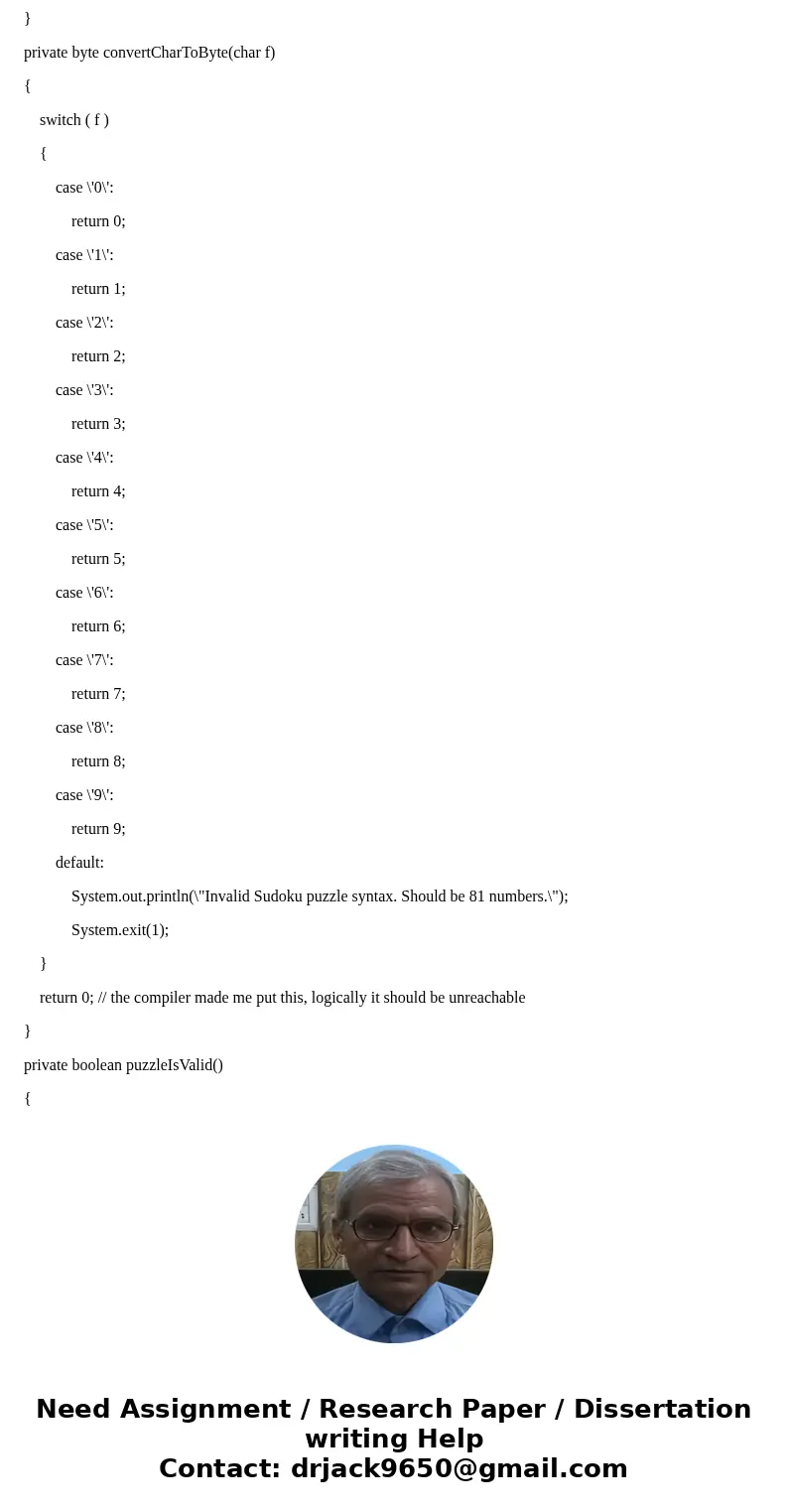
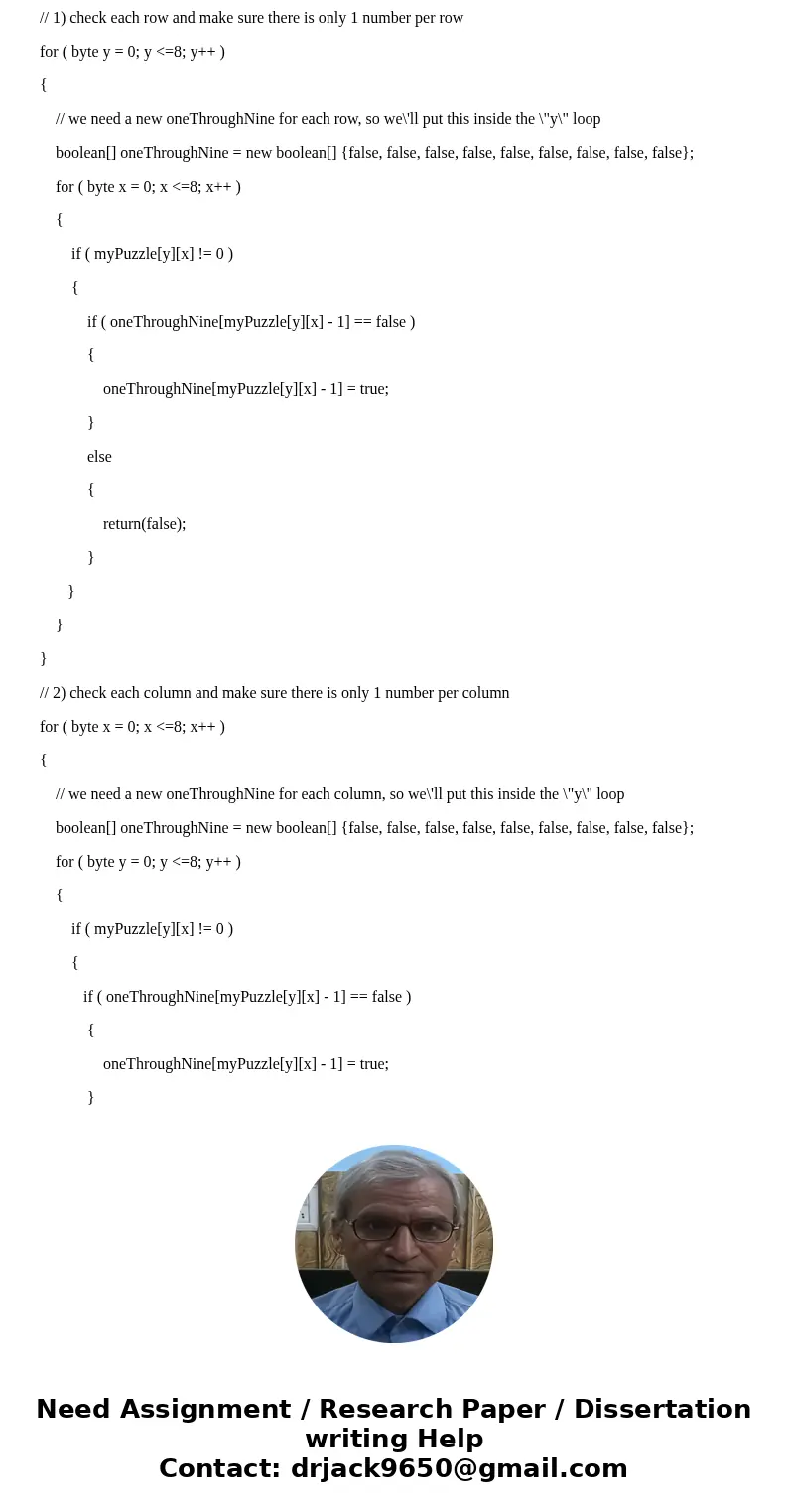
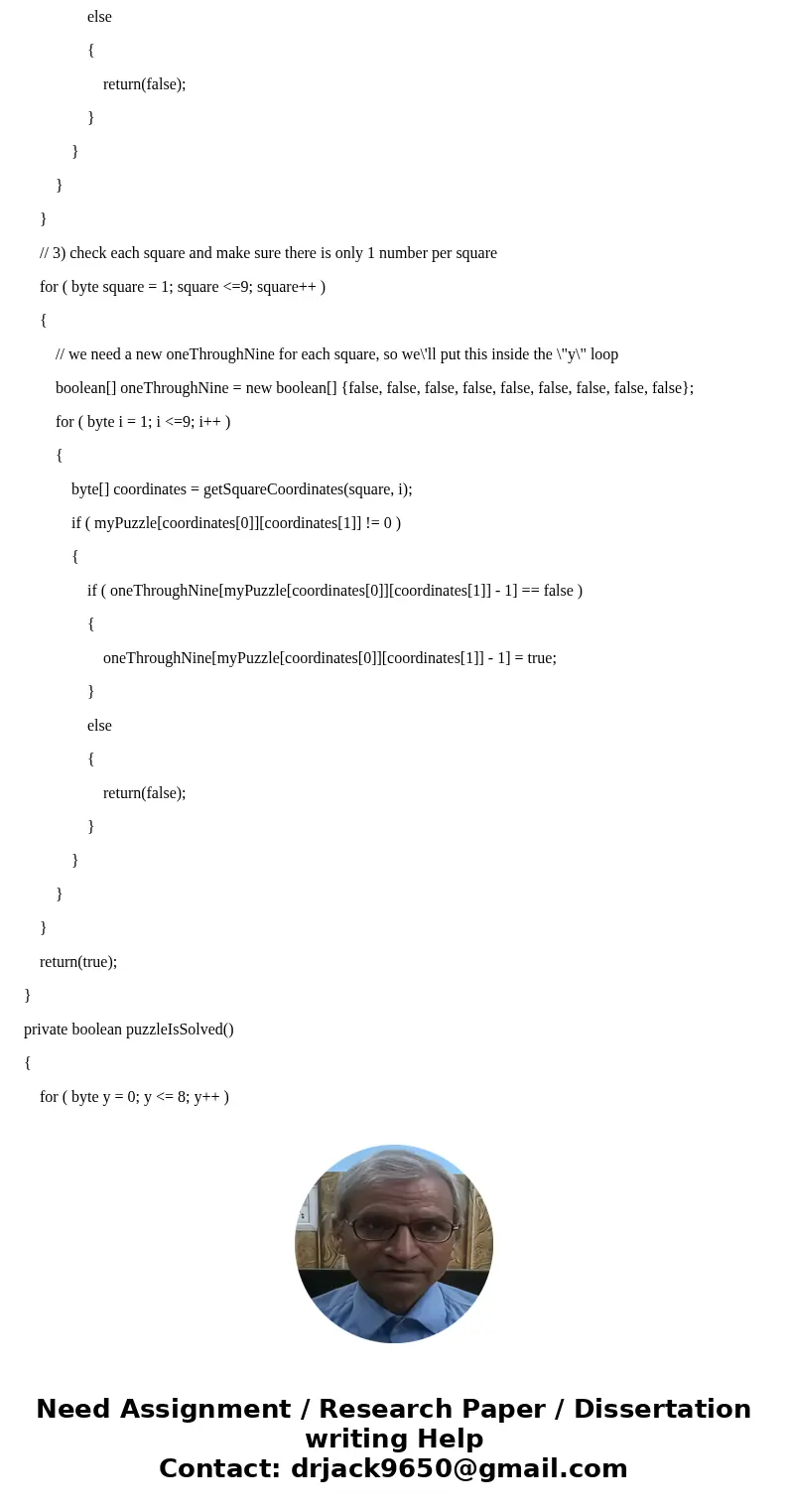
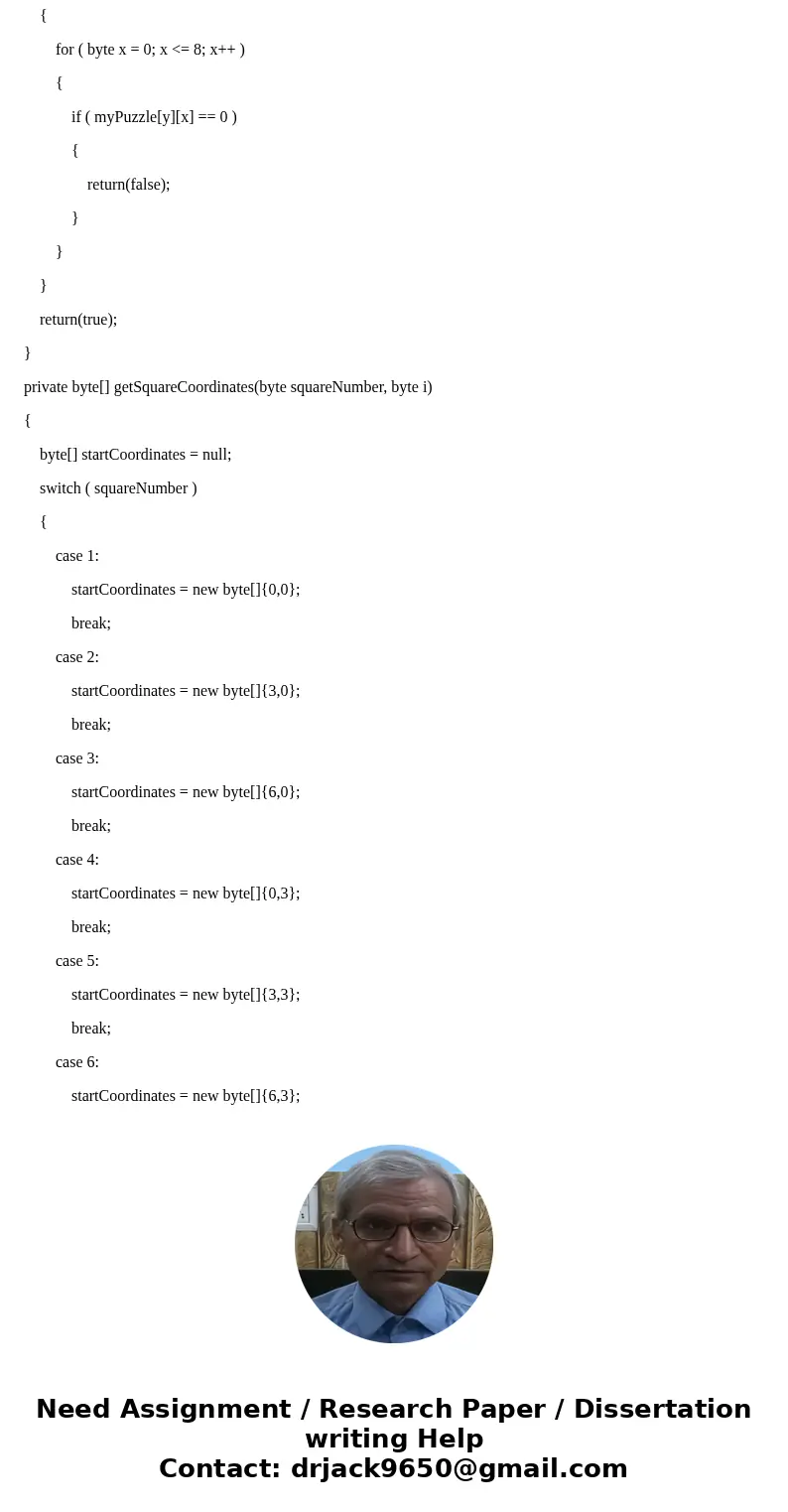
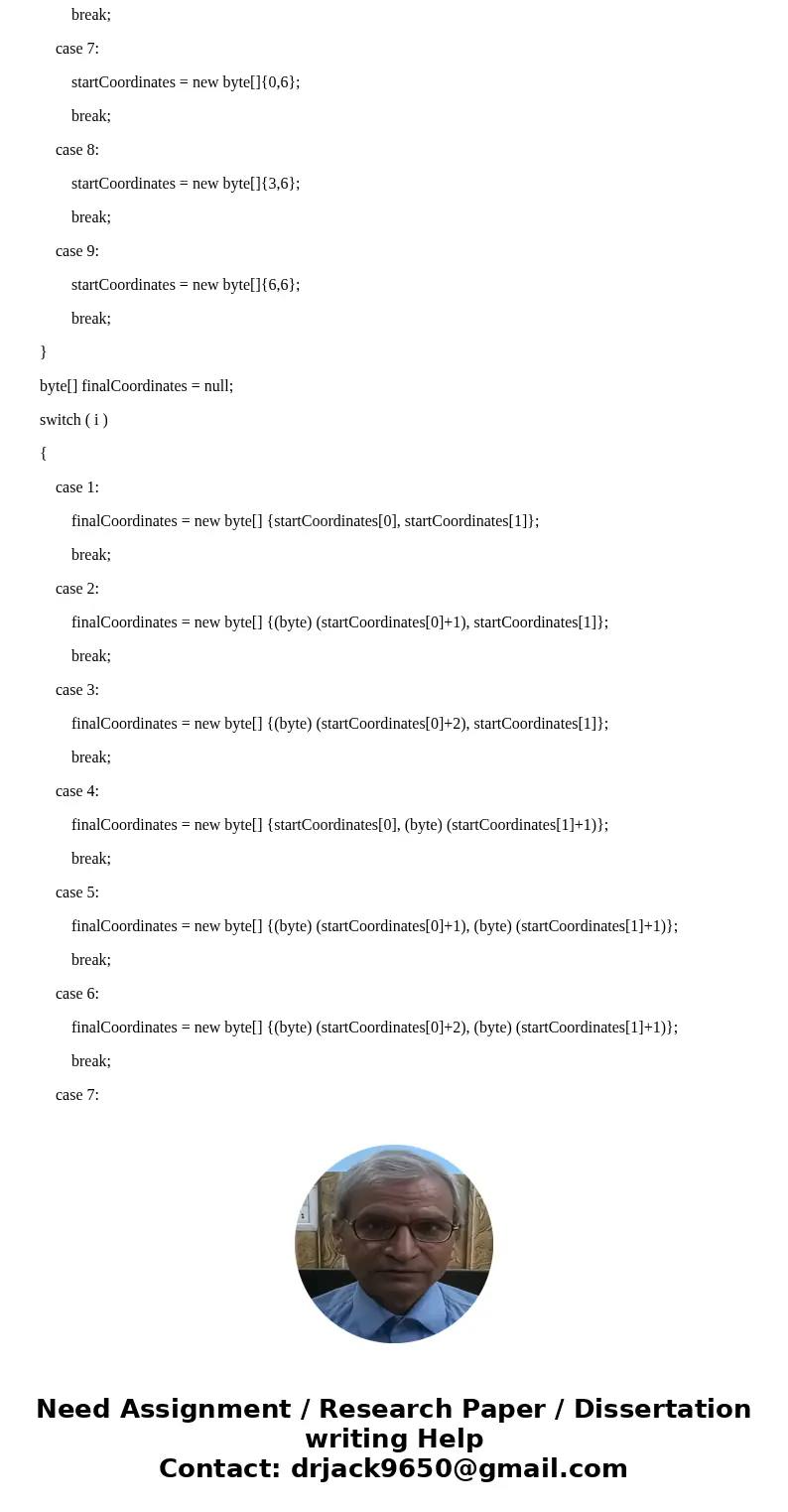
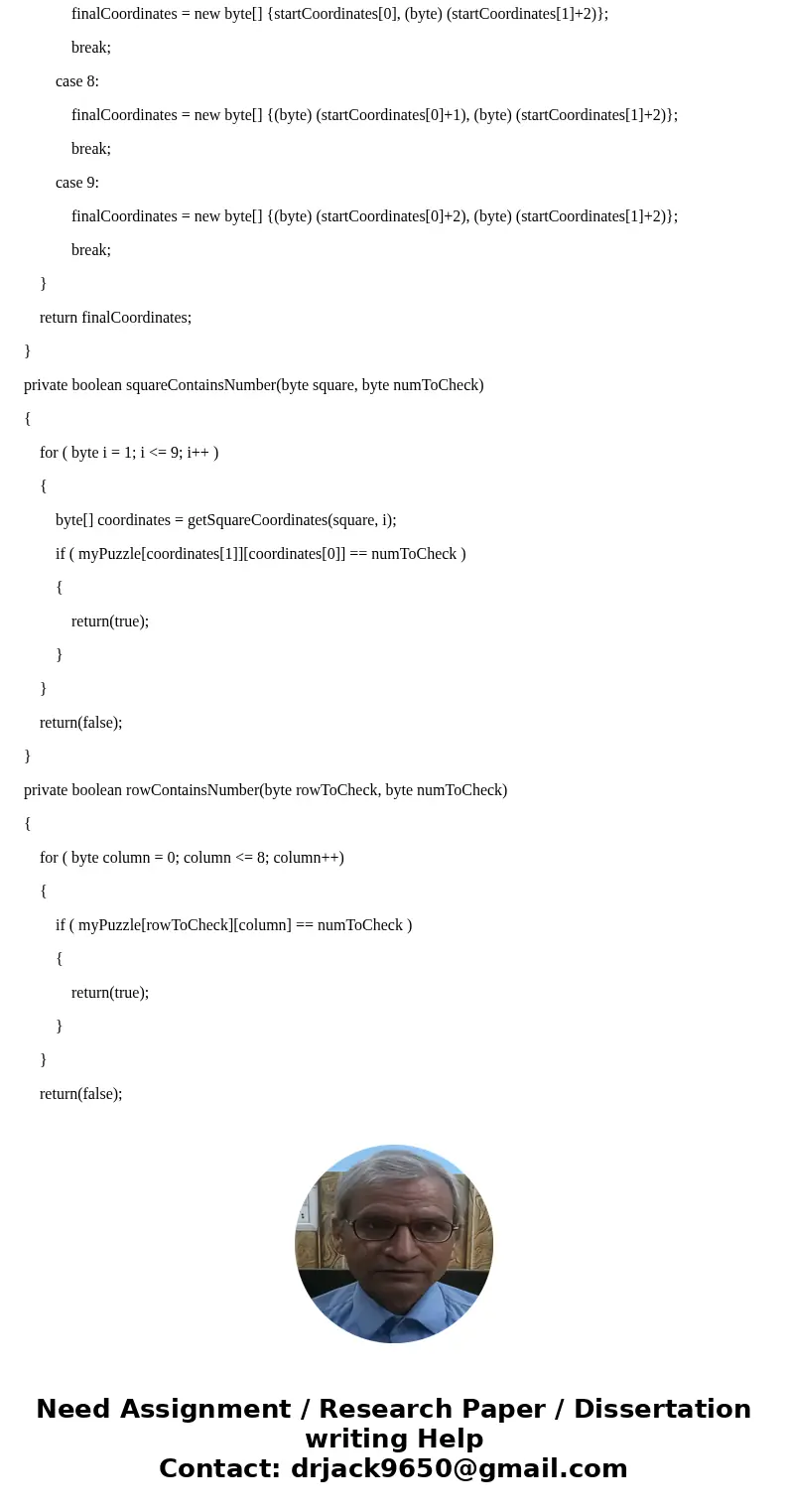
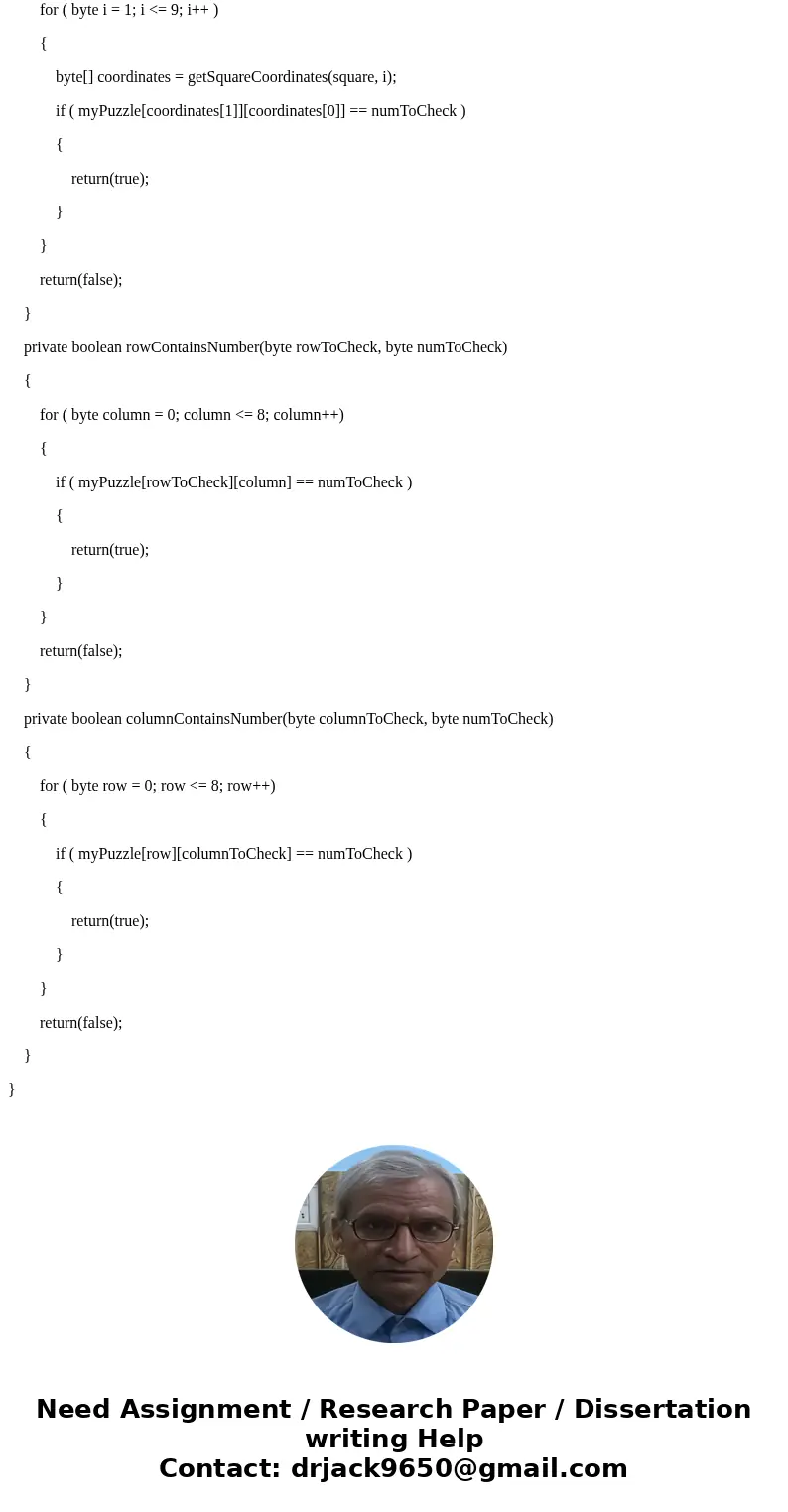
 Homework Sourse
Homework Sourse